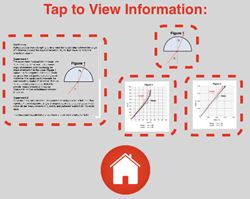About Snell's Law
Highly Recommended

Like all our Science Reasoning Center activities, the completion of the Snell's Law activity requires that a student use provided information about a phenomenon, experiment, or data presentation to answer questions. This information is accessible by tapping on the small thumbnails found on the bottom right of every question. However, it may be considerably easier to have a printed copy of this information or to display the information in a separate browser window. You can access this information from
this page.
The Standards
The Snell's Law activity describes two experiments in which students investigate the effect of the angle of incidence upon the angle of refraction. Data is collected for the air-water and the air-lucite boundary and presented as an angle of incidence vs. angle of refraction graph and as a sine of the angle of incidence vs. sine of the angle of refraction graph. Questions target a student's ability to understand the design of an experiment, to predict the outcome of performing the experiment in a different manner, to identify the qualitative relationship among variables, to combine two or more data presentations in order to develop appropriate conclusions, and to use a model in order to analyze information and draw appropriate conclusions.
Success with the activity requires some degree of proficiency with respect to ...
- Developing and Using Models (Science and Engineering Practice 2.1)
Evaluate merits and limitations of two different models of the same proposed tool, process, mechanism, or system in order to select or revise a model that best fits the evidence or design criteria.
- Developing and Using Models (Science and Engineering Practice 2.3)
Develop, revise, and/or use a model based on evidence to illustrate and/or predict the relationships between systems or between components of a system.
- Developing and Using Models (Science and Engineering Practice 2.5)
Develop a complex model that allows for manipulation and testing of a proposed process or system.
- Planning and Carrying Out Investigations (Science and Engineering Practice 3.5)
Make directional hypotheses that specify what happens to a dependent variable when an independent variable is manipulated.
- Analyzing and Interpreting Data (Science and Engineering Practice 4.1)
Analyze data using tools, technologies, and/or models (e.g., computational, mathematical) in order to make valid and reliable scientific claims or determine an optimal design solution.
- Analyzing and Interpreting Data (Science and Engineering Practice 4.2)
Apply concepts of statistics and probability (including determining function fits to data, slope, intercept, and correlation coefficient for linear fits) to scientific and engineering questions and problems, using digital tools when feasible.
- Analyzing and Interpreting Data (Science and Engineering Practice 4.5)
Evaluate the impact of new data on a working explanation and/or model of a proposed process or system.
- Using Mathematics and Computational Thinking (Science and Engineering Practice 5.3)
Use mathematical, computational, and/or algorithmic representations of phenomena or design solutions to describe and/or support claims and/or explanations.
- Patterns (Crosscutting Concept 1.3)
Classifications or explanations used at one scale may fail or need revision when information from smaller or larger scales is introduced; thus requiring improved investigations and experiments.
- Patterns (Crosscutting Concept 1.5)
Mathematical representations are needed to identify some patterns.
- Scale, Proportion, and Quantity (Crosscutting Concept 3.2)
Algebraic thinking is used to examine scientific data and predict the effect of a change in one variable on another (e.g., linear growth vs. exponential growth).
While the Snell's Law activity addresses the eight NextGen Science and Engineering Practices and the three Crosscutting Concepts above, the activity drew its greatest inspiration from
ACT's College Readiness Standards for Science Reasoning. The activity consists of 64 questions organized into 16 Question Groups that are spread across the three difficulty levels. All three strands (Interpretation of Data - IOD; Science Investigation - SIN; and Evaluation of Models, Inferences, and Experimental Results - EMI) of the College Readiness Standards are addressed in this activity. The code given for the standard includes three letters to indicate the strand and three numbers to indicate the specific standard within that strand. Higher numbers are indicative of more complex science reasoning skills. The relationship between the questions and the standards is as follows:
Complementary and Similar Resources
The following resources at The Physics Classroom website complement the Snell's Law Science Reasoning Activity. Teachers may find them useful for supporting students and/or as components of lesson plans and unit plans.
Physics Classroom Tutorial, Refraction and the Ray Model of Light Chapter: Snell's Law
Physics Video Tutorial, Refraction and Lenses: Snell's Law
Physics Interactives, Refraction and Lenses: Refraction Simulation
Physics Interactives, Refraction and Lenses: Least Time Principle
Minds On Physics, Refraction and Lenses Module, Mission RL4: Snell's Law
The Calculator Pad, Refraction and Lenses, Problem Sets RL4 - RL9